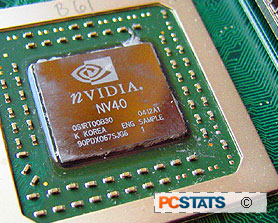
|
NV40, in comparison, sports no less than 222 million transistors on IBM's 130nm process. The graphics processor wields 16 pixel-pipelines and a 256-bit memory bus populated by GDDR-3 memory modules.
80% Rating: 
|
|
|
|
Home >
Reviews >
Video Cards >
Nvidia Geforce 6800 Ultra |
|
|
nVidia Geforce 6800 Ultra Reference Videocard Review
There's
an old adage that reads something along the lines of "the only two sure things
in life are death and taxes." Whoever coined that saying clearly wasn't a gamer.
If they had been, it would have read "the only three sure things in life are
death, taxes, and the obsolescence of your video card in six short months.
Sorry. And your total comes to $424.67 - will that be cash or
credit?."
Without
fail, the perpetual battle between videocard manufacturers results in faster
video cards and lower prices. The cycle of tit-for-tat comes full circle with
the recent unveiling of the Radeon X800 XT, a brutish piece of hardware designed
to do battle with nVidia's lean green GeForce 6800 Ultra. Actually, both
cards were designed to tear through all of the latest games at 1600x1200 with
anti-aliasing and anisotropic filtering cranked up through the roof. It's all a
matter of which card does it faster, conferring the best image quality in the
process.
nVidia's
NV40 GPU is a particularly important development for the company. After delaying
the GeForce FX 5800 launch, nVidia played a year-long game of catch-up,
complicated by a number of driver issues - specifically, software optimizations
aimed at enhancing performance in certain benchmark applications. In fact, right
up until it unveiled NV40 GPU in mid-April this year, nVidia hadn't enjoyed a
significant performance advantage since the days of its GeForce 4 Ti 4600
videocard. Then, suddenly, the game changed, and NV40 showed everyone that
nVidia was back in the game.
In order to
fully appreciate the level of technical complexity involved in manufacturing
NV40, the chip powering nVidia's GeForce 6800 Ultra, consider that the GeForce
FX 5950 Ultra consists of 130 million transistors on TSMC's 130nm manufacturing
process. It comes equipped with four pixel pipelines, each with two texture
units and is backed by DDR memory on a 256-bit bus.
NV40, in
comparison, sports no less than 222 million transistors on IBM's 130nm process.
The graphics processor wields 16 pixel-pipelines and a 256-bit memory bus
populated by GDDR-3 memory modules. In its GeForce 6800 Ultra configuration,
NV40 runs at 400MHz for a peak fill-rate of 6.4GPixels per second and as many
texels.
 The
GeForce 6800 Ultra also boasts a 256MB frame buffer running at 550MHz,
effectively 1.1GHz. Theoretically, the card should enjoy up to 35.2GB per second
of memory bandwidth, though the effective rates are somewhat lower. The
GeForce 6800 Ultra also boasts a 256MB frame buffer running at 550MHz,
effectively 1.1GHz. Theoretically, the card should enjoy up to 35.2GB per second
of memory bandwidth, though the effective rates are somewhat lower.
One of the
most prevalent features of the reference GeForce 6800 Ultra design, which
third-party manufacturers may or may not adopt, is the dual DVI display output.
NV40 doesn't natively feature a TMDS transmitter, so digital outputs are enabled
through a pair of Silicon Image add-on chips.
Like the GeForce FX 5950 Ultra before it, nVidia's GeForce 6800
Ultra consumes two slots - an AGP slot and its adjacent PCI slot - to
accommodate the large, aluminum heatsink and squirrel cage fan mounted atop the
graphics processor. Such a configuration presents problems when it comes to
small form-factor systems, but the loss of one PCI slot in a typical desktop PC
is not that big a deal for most gamers. nVidia is at a slight physical
disadvantage when you compare it's 6800 Ultra reference card to its main
competition, the Radeon X800 XT - a single-slot design that dissipates less
heat than the 9800 XT before it.
As has been
the case with the FX5950 Ultra, most manufacturers will opt to design their own
cooling solutions which are quieter, and slimmer, rather
than stick with the reference heatsink.
Fortunately, the fan cooling nVidia's new heatsink assembly
is quieter than the original GeForce FX 5800 Ultra, and utilizes two speed
settings - one for idling in 2D mode and another for dealing with the heat
created by 222 million transistors while running 3D games. However, at no
point during testing did the 6800 Ultra revert to the faster, noisier setting.
|

